Artblog review of books
Richard Renaldi: Figure and Ground
156 pages
90 four-color images
hardcover with jacket
Aperture, New York
ISBN-13: 978-1-59711-029-7
$45
My sister Cate told me last summer about a book coming out that she was excited to see, Richard Renaldi: Figure and Ground.
Renaldi was a student of hers at NYU, and this hardcover book published by Aperture is an achievement! I got my copy about a month ago and it’s a thing of beauty.
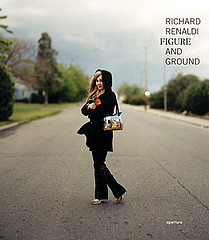
Christine, Fresno, CA, 2003
Renaldi is a portraitist and whether it’s people or the land (and there are both in this book of the artist’s travels across America) his works are a great quest to understand. His portraits of ordinary American people are so emotionally revealing and beautiful they will make your heart ache. His landscapes evoke the anti-sublime. Not a mountain in sight in these works, just vast spaces that dwarf the viewer and announce that they were once-gorgeous but are now trampled and misused. The landscapes are interesting, but it’s the people portraits that make the book — and make the photographer — great. And hallelullah! there’s no irony in the enterprise anywhere.
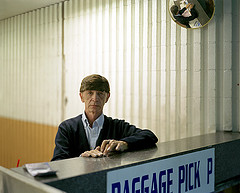
Ernest, Denver, 2005
Whether young or old, man or woman, Renaldi’s people are at ease with themselves, with the camera and with the photographer, and they bare themselves. There are few smiles here. Mostly what you see, even in the group shots, is serious faces, and loneliness that is as much about the human condition as I have seen in a work of art. I’ve gone through the book a half dozen times now, turning the pages, wanting to touch the people he’s captured and wanting to know more. The experience gets better, deeper, richer each time.
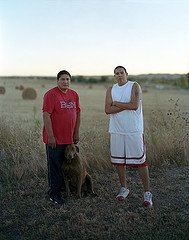
William and Morgan, 2005
The book has 90 images each showcased on an individual page, so the whole feels like an exhibit or portfolio. The pacing of the book is nice, with distanced shots and extreme distanced landscapes punctuated by an occasional extreme close-up that makes you draw a breath from the clear-eyed close-encounter.
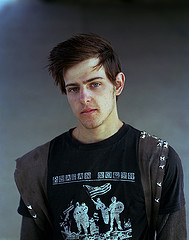
Scott, Laramie, Wy 2005
A short essay by London-based independent curator and writer Roger Hargreaves is meaty and informative. Hargreaves puts in the shorthand you need to make comparisons and situate the work in photography’s family tree: He compares Renaldi with American masters of the road trip genre like Stephen Shore, Walker Evans and Robert Frank. And he puts Renaldi in the taxonomic portrait traditions of the German photographer, August Sander. The unexpected comparison — and this is a great one — is to the anonymous practitioners of daguerrotype photography — photographers for hire — who roamed the country and chronicled the nation’s people in photography’s early days.
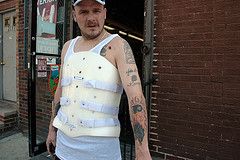
Zoe Strauss, gunshot
I want to say that both in his attraction to people and in his ability to put them at ease and make what are great portrait photographs, Rinaldi reminds me of the wonderful Zoe Strauss, whose portraits have the same lonely humanity in them and the same quest to understand.
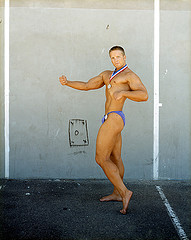
Olli, Venice, CA, 2004
Renaldi’s book spans his travels across America from 2000-2005. Over that time the artist shot film in New York and 16 other states including New Jersey (Newark), Pennsylvania (Philadelphia), Kentucky, Georgia, Michigan, Indiana, Arizona, New Mexico, Utah, Wyoming, Nebraska, Colorado, Oklahoma, South Dakota, Kansas, California, Texas. The artist, who graduated from NYU in 1990 and whose work was included in the first ICP Triennial of Photography (2003)works with a large format camera. He drags his cumbersome set-up around with him, finds someone and some place to shoot film and negotiates his way to a spontaneous picture shoot. Hargreaves compares this to a fashion shoot without the fashion. And indeed there is the sense of a conscious set up. The locations are telling backdrops — often they are vast spaces like an open road or in urban settings, an interesting piece of architecture or infrastructure that dwarfs the human yet plays up the sitter’s humanity.
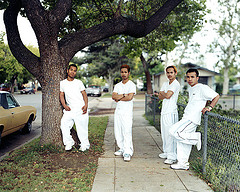
Dy, Thai, Sokha, Lay, 2003, Fresno
On his website, Renaldi has his work grouped by projects including bodybuilders, Fresno, the farm, fathers and sons, the great plains, tattoo boys and one of my favorites, bus travelers. The book pulls some of the strongest images from the projects and lets them run together – ungrouped from their project moorings – to become a wash of contemporary people and places. The flow of images in the book reminds me of how Zoe Strauss agonizes over the flow of her images for her Under-I-95 exhibit and for the slide shows she puts together. And indeed the flow is important. And here in the book, the story that unfolds from East Coast to West, is one of 21st Century nomads. The “family of nomadic man.”
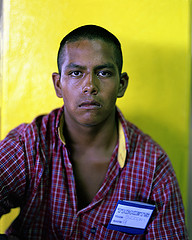
Jaime, Denver, 2005
Christine, (top image) pivoting on the road to face you with her Mona Lisa smile and worried brow is one of the few works with anything like motion in them. Apart from Christine, the people pictured seem not to have much to be smiling at and they are still as rocks. Jaime, Denver, 2005, a bus rider with ticket in his pocket, sits in front of a harsh yellow-painted wall looking tired and maybe a little bit threatening. The picture’s subtitle tells you he’s going from Denver to Witchita Falls, TX, and, like all the many travelers pictured in this book, you wonder about his story.
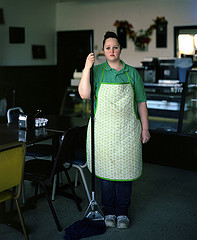
Erica, 2005, Alliance, Neb.
Renaldi’s work interests me because he is a photographer who stands back and becomes invisible and lets his subjects speak. The work is generous that way. And what these 21st century Americans seem to be saying is that they are not necessarily happy to be here but that they are working hard and playing when they can and that maybe just maybe they will continue to believe in the possibility of good. There is hope in these images, it’s just a little buried.
Cate emailed me to say the Renaldi is having a book signing this week in New York. Thursday, Oct 12, at 6:30 p.m. at Aperture Gallery, 547 W 27Street, 4th floor. 212 505-5555
And finally, the artist has a solo exhibit with Yossi Milo Gallery opening Jan 25, 2007. (That’s a great photography gallery where Libby and I saw work by Loretta Lux and Steve and I saw work bySze Tsung Leong.)









